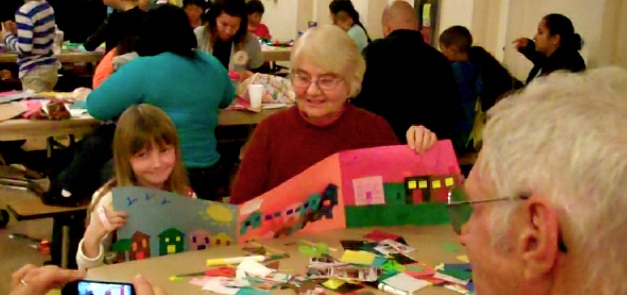

"Creativity ... constitutes the greatest legacy people can leave to their children, grandchildren, and society as a whole."
This is according to an article published in the September, 2008 Americans for the Arts (AFTA) Monograph. I agree, and will go even further saying that creativity is a gift children can pass to their parents and grandparents, too, as it may be the only skill than can be equally enhanced by a lack of experience as a wealth of it. As Picasso said, "It took me four years to paint like Raphael, but a lifetime to paint like a child." Being an educator, I have witnessed firsthand the profound benefits of intergenerational programming, particularly in the arts, for all participants. As a granddaughter and parent of young children, I also have ample experience falling into the generational potholes that can undermine learning and teaching. My favorite memories of my grandmother, for example, are of us knitting and making dollhouse furniture together. My least favorite memory is of trying to teach her how to use a VCR (it was equally unpleasant explaining what a VCR is to my daughter who, like some of you I imagine, had never heard of one).
U.S. Census Bureau data shows that the population of older Americans is surging, and multigenerational households are on the rise. Two, three, and even four generation households have increased by 30% in Southern California in the last decade. No responsible education institution can ignore both the challenges and potential benefits of educating children who are increasingly being cared for and with their grandparents. The rise of multigenerational households can be attributed to a variety of circumstances, including financial, medical, and cultural, and there are both practical hardships and advantages to multigenerational living. The middle generation, or "sandwich" generation, may be faced with caring for elder parents and young children simultaneously. On the other hand, multiple generations under one roof may mean reduced child care costs, and increased ability for the sandwichers to return to school or pursue new career paths. The most compelling benefits, however, from my perspective as an arts educator, are those beyond easy measure. These include greater closeness between children and their grandparents, and more occasions for all generations to benefit from the knowledge, creativity, and experiences of the others.
Having had countless opportunities to observe families engaged in arts activities, I can personally attest to the precious creative and cultural resources that grandparents pass on to younger generations. Likewise, I've seen the joy, companionship, and intellectual stimulation kids can give to their elders in return. The arts, in particular, provide a line of communication that transcends generational divides, providing common ground for young and old alike on which to explore modern solutions to age-old human dilemmas. A 2011 National Endowment for the Arts study notes:
Art can foster positive attitudes and enhance commonality with older adults. The arts provide a sense of community through sharing an activity, looking past stereotypes, using the mind, and engaging the senses.
This resonates strongly with me because in 2009 P.S. ARTS revised its eighteen year-old mission from "restoring the arts to public education...," to "improving the lives of children by providing arts education to underserved schools and communities." The change emphasizes that children's welfare is paramount and inextricably linked to the welfare of communities, which are including older adults in greater number and domestic proximity. The children we serve are more often relying on the care and support of their grandparents to help them navigate an increasingly complex social and technological environment, and vice versa. As an arts education organization, we need to question what kinds of programs we can offer that best equip parents and grandparents, along with teachers, to help children thrive in the 21st century.
In response to this challenge, P.S. ARTS launched a community outreach initiative in 2010 designed to bring multiple generations together to make and learn about art. In the last two years, we have hosted thousands of families at events featuring arts activities based on the work of master artists and accessible to people of diverse abilities, backgrounds, and ages. P.S. ARTS also actively supports school districts' in implementing intergenerational arts programming with the creation of the TakePART (Public-school Arts Regional Team) effort. The TakePART effort currently includes five Southern California school districts unified by the philosophy that the arts are essential to academic success and community life.
The first annual TakePART Regional Arts Festival -- Connecting Communities Creatively -- will be held on Saturday, June 02, 2012 from 10 a.m. to 2 p.m. at R.H. Dana Middle School in Hawthorne, CA. This free intergenerational event will feature student artwork and performances from five school districts, and include hands-on art activities, artist workshops, and live music, theater and dance. We look forward to celebrating the arts in these communities along with the community spirit itself.